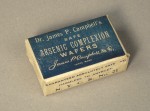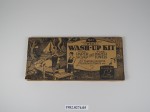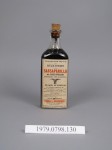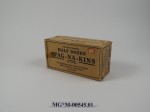 Included in the National Museum of American History’s enormous collection of 90,000 artifacts in the Division of Medicine and Science are more than 2,200 historic cosmetic, hygiene and personal care products. Most of them have never been on display and outside of museum curators, people don’t even know they’re there. Thanks to a grant from Kiehl’s, a skincare company founded in 1851 which has over the years donated more than 100 items from its own past to the Smithsonian, the collection has now been digitized.
Included in the National Museum of American History’s enormous collection of 90,000 artifacts in the Division of Medicine and Science are more than 2,200 historic cosmetic, hygiene and personal care products. Most of them have never been on display and outside of museum curators, people don’t even know they’re there. Thanks to a grant from Kiehl’s, a skincare company founded in 1851 which has over the years donated more than 100 items from its own past to the Smithsonian, the collection has now been digitized.
The National Museum of American History, with the support of Kiehl’s, plans to extend the collection to the Web through the Cosmetics and Personal Care Collections Digitization Project. A museum specialist will identify, photograph and provide descriptive information for the cosmetic and personal care objects collection on the Web. The project will allow the museum’s collection of cosmetics and personal care products to be accessed online for education and research around the world.
 The objects date from the 19th century to the present and include everything from skin creams to soaps, perfumes, razors and tooth powders. The range of products and dates provides a fascinating view of how drastically beauty standards and personal care regimens have changed over the years. Browsing the collection you can tread the dangerously fine line between medicine and makeup, poison and perfume. The inextricable link between medicine and cosmetics was acknowledged by Congress in 1938 when it passed the Food, Drug, and Cosmetics Act giving the Food and Drug Administration some degree of regulatory oversight over the cosmetic industry.
The objects date from the 19th century to the present and include everything from skin creams to soaps, perfumes, razors and tooth powders. The range of products and dates provides a fascinating view of how drastically beauty standards and personal care regimens have changed over the years. Browsing the collection you can tread the dangerously fine line between medicine and makeup, poison and perfume. The inextricable link between medicine and cosmetics was acknowledged by Congress in 1938 when it passed the Food, Drug, and Cosmetics Act giving the Food and Drug Administration some degree of regulatory oversight over the cosmetic industry.
 The grant comes none to soon as soaps and the paper box they came in were not made to last. These were disposable items and there isn’t a lot conservators can do to keep them from crumbling to dust. Then there are the inevitable chemical reactions, like between toothpaste and its old tubes.
The grant comes none to soon as soaps and the paper box they came in were not made to last. These were disposable items and there isn’t a lot conservators can do to keep them from crumbling to dust. Then there are the inevitable chemical reactions, like between toothpaste and its old tubes.
If you’re researching something of have a particular interest in one type of product, you can search the collection by  keyword. I got a kick out of searching for poisons like arsenic and lead, which have been mainstays of skin care products since antiquity. I also had fun picking more general old-timey keywords like “tonic” and browsing all the quackery and impossible claims that ensued. If you’d just like to have a look around, click on one of the categories listed in the column to the right of the page. I enjoyed clicking on each category and then scrolling down to the filter options, clicking the date, and exploring the whole category from oldest to newest.
keyword. I got a kick out of searching for poisons like arsenic and lead, which have been mainstays of skin care products since antiquity. I also had fun picking more general old-timey keywords like “tonic” and browsing all the quackery and impossible claims that ensued. If you’d just like to have a look around, click on one of the categories listed in the column to the right of the page. I enjoyed clicking on each category and then scrolling down to the filter options, clicking the date, and exploring the whole category from oldest to newest.
 Did you know that after World War I, they made menstrual pads out of sphagnum moss? Apparently they were first invented during the war for use in surgical dressings and later found new life as a consumer product. That brings me back to the wonderful barrels of 14th century poop found in Odense, Denmark, in which clumps of moss were found because they were used as toilet paper. Damn good toilet paper at that.
Did you know that after World War I, they made menstrual pads out of sphagnum moss? Apparently they were first invented during the war for use in surgical dressings and later found new life as a consumer product. That brings me back to the wonderful barrels of 14th century poop found in Odense, Denmark, in which clumps of moss were found because they were used as toilet paper. Damn good toilet paper at that.
The collection is full of cool random finds like this. The digitization project will continue to keep up with new acquisitions.